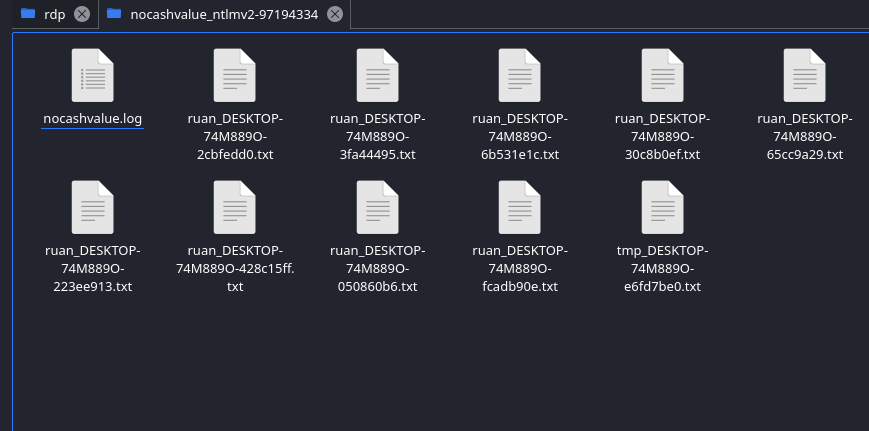首先你要有一个pcap文件且含有NTLM v2哈希
1.ntlmssp过滤
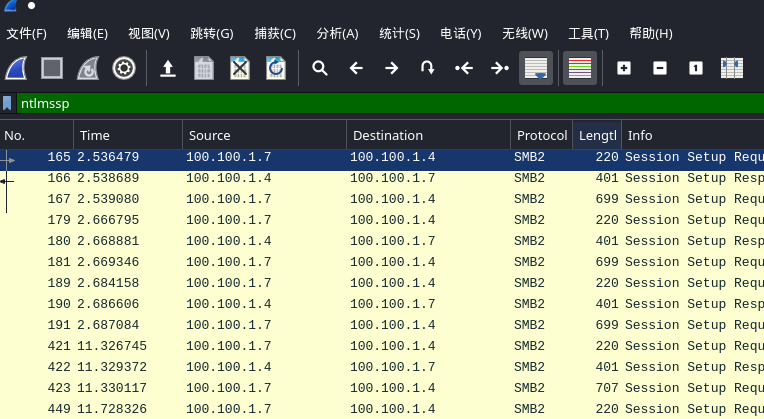
2.为了破解ntlmv2,我们需要找到如下信息
username::domain:ServerChallenge:NTproofstring:modifiedntlmv2response
3.找到NTLMSSP_AUTH包,并过滤到下图内容
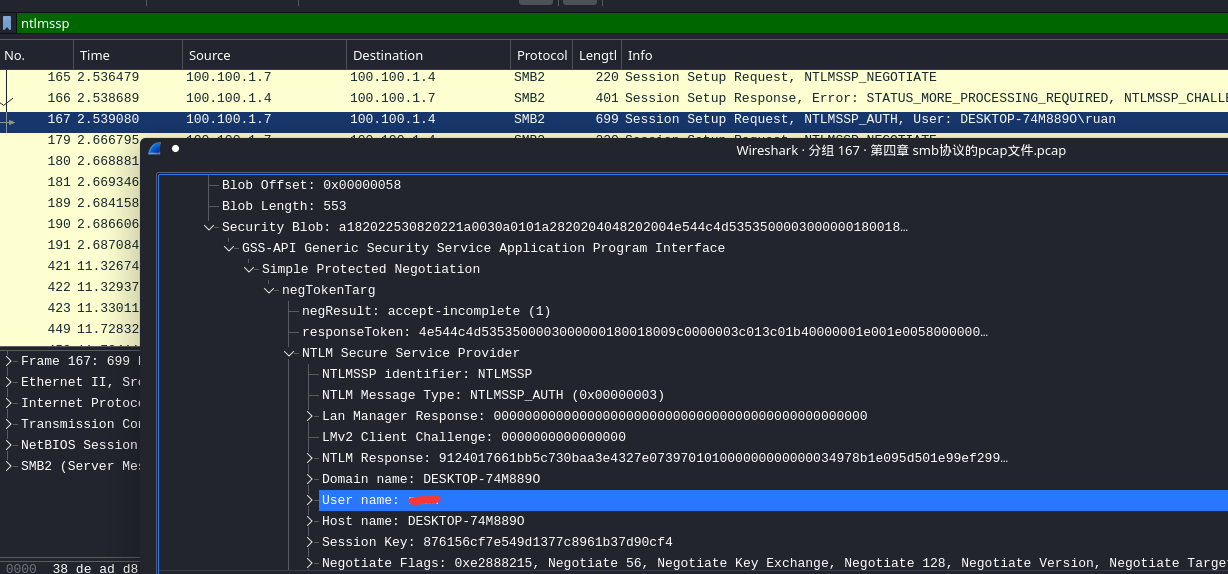
可获得
username和domain
4.追踪NTLM response

可获得NTproofstring和modifiedntlmv2response
此处注意ntlmv2response的开头是NTproofstring,需要删除ntlmv2response里的重复部分
5.过滤搜索ntlmssp.ntlmserverchallenge,找到符合条件的包
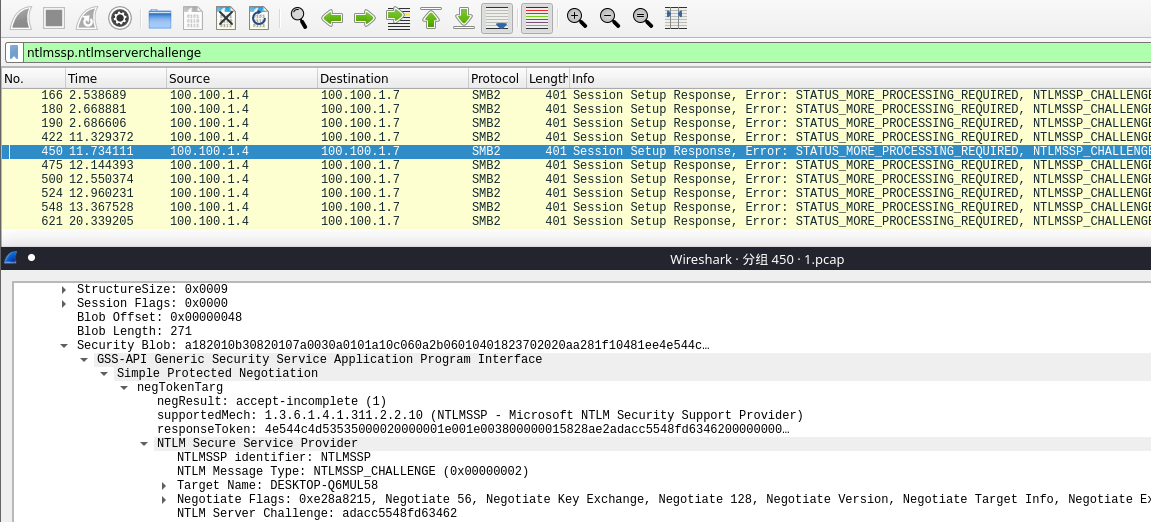
获得NTLM Server Challenge
自此,获得了username::domain:ServerChallenge:NTproofstring:modifiedntlmv2response 的所有信息
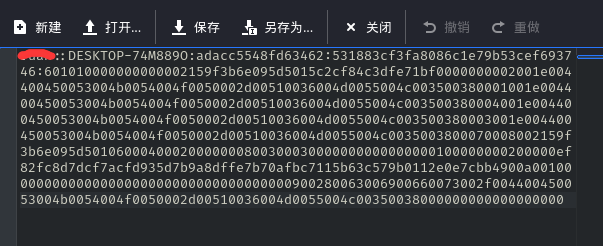
6.将该字符串保存后使用hashcat破解
hashcat -m 5600 保存的字符串.txt 密码字典.txt -o 结果.txt --force
hashcat具体操作可参考https://blog.csdn.net/SHIGUANGTUJING/article/details/90074614
7.利用python自动提取pcap包中的ntlmv2 hash
可参考https://github.com/gh-balthazarbratt/nocashvalue
#!/usr/bin/python3 import os, sys, subprocess, json, logging, argparse from uuid import uuid4 parser = argparse.ArgumentParser(description='Extracts NTLMv2 tokens from pcaps and creates files ready to be consumed by hashcat') parser.add_argument('--tshark_path', type=str, help='full path to tshark executable', required=True) parser.add_argument('--pcap_file', type=str, help='full path to pcap file', required=True) args = parser.parse_args() tshark_path = args.tshark_path pcap_file = args.pcap_file # Change the value below based on your system paths, it is set for *nix type systems tmp = '/tmp' # Set temporary directory and log file names scr_dir = 'nocashvalue_ntlmv2-' + uuid4().__str__()[:8] tmp_scr_dir = tmp + '/' + scr_dir log_file = 'nocashvalue.log' # Create script tmp directory os.mkdir(tmp_scr_dir) # Setup logger logger = logging.getLogger('nocashvalue') logger.setLevel(logging.DEBUG) fh = logging.FileHandler(tmp_scr_dir+'/'+log_file) fh.setFormatter(logging.Formatter('%(asctime)s - %(levelname)s - %(message)s')) logger.addHandler(fh) logger.info('Logger initialized') challenge_filter_str = "'ntlmssp.identifier == NTLMSSP and ntlmssp.messagetype == 0x00000002'" blob_filter_str = "'ntlmssp.identifier == NTLMSSP and ntlmssp.messagetype == 0x00000003'" challenge_str_cmd = "{} -r {} -Y{} -Tjson -e ntlmssp.auth.username -e ntlmssp.auth.domain -e ntlmssp.ntlmserverchallenge -e ntlmssp.ntlmv2_response.ntproofstr -e ntlmssp.ntlmv2_response".format(tshark_path, pcap_file, challenge_filter_str) blob_str_cmd = "{} -r {} -Y{} -Tjson -e ntlmssp.auth.username -e ntlmssp.auth.domain -e ntlmssp.ntlmserverchallenge -e ntlmssp.ntlmv2_response.ntproofstr -e ntlmssp.ntlmv2_response".format(tshark_path, pcap_file, blob_filter_str) logger.info('Executing "{}" in a subprocess shell'.format(challenge_str_cmd)) pipe1 = subprocess.Popen(challenge_str_cmd, stdout=subprocess.PIPE, shell=True) logger.info('Child process pid is {} and it exited with {}'.format(pipe1.pid, pipe1.returncode)) logger.info('Executing "{}" in a subprocess shell'.format(blob_str_cmd)) pipe2 = subprocess.Popen(blob_str_cmd, stdout=subprocess.PIPE, shell=True) logger.info('Child process pid is {} and it exited with {}'.format(pipe2.pid, pipe2.returncode)) challenge_str_output = pipe1.stdout.read() blob_str_output = pipe2.stdout.read() # This is a list of dictionaries challenge_str_json = json.loads(challenge_str_output.decode('UTF-8')) logger.info(json.dumps(challenge_str_json, indent=2)) blob_str_json = json.loads(blob_str_output.decode('UTF-8')) logger.info(json.dumps(blob_str_json, indent=2)) # Log the fact that the number of server challenge packets # are different than the number of ntlmv2_response packets and exit if (len(challenge_str_json) != len(blob_str_json)): sys.stdout.write('Number of SMB2 packets containing NTLM Server Challenge tokens are different than the number of packets containing NTLMv2 responses. See {} for details.'.format(tmp_scr_dir+'/'+log_file)) exit() packets = [] # Merge server challenge tokens with the rest of the ntlmv2_response details # Caveat: We assume that the packets are received in chronological order such that # the packet which contains server_challenge token appears right before the packet # that contains NTLMv2_response it is associated with for i, blob_pkt in enumerate(blob_str_json): username, domain, server_challenge, ntproofstr, ntlmv2_response = ['', '', '', '', ''] if (len(blob_pkt['_source']['layers']) > 0 and 'ntlmssp.auth.username' in blob_pkt['_source']['layers']): username = blob_pkt['_source']['layers']['ntlmssp.auth.username'][0] if (len(blob_pkt['_source']['layers']) > 0 and 'ntlmssp.auth.domain' in blob_pkt['_source']['layers']): domain = blob_pkt['_source']['layers']['ntlmssp.auth.domain'][0] if (len(challenge_str_json[i]['_source']['layers']) > 0 and 'ntlmssp.ntlmserverchallenge' in challenge_str_json[i]['_source']['layers']): server_challenge = challenge_str_json[i]['_source']['layers']['ntlmssp.ntlmserverchallenge'][0] if (len(blob_pkt['_source']['layers']) > 0 and 'ntlmssp.ntlmv2_response.ntproofstr' in blob_pkt['_source']['layers']): ntproofstr = blob_pkt['_source']['layers']['ntlmssp.ntlmv2_response.ntproofstr'][0] if (len(blob_pkt['_source']['layers']) > 0 and 'ntlmssp.ntlmv2_response' in blob_pkt['_source']['layers']): ntlmv2_response = blob_pkt['_source']['layers']['ntlmssp.ntlmv2_response'][0] if len(ntlmv2_response) > 0: ntlmv2_response = ntlmv2_response[31:] packets.insert(i, {'username': username, 'domain': domain, 'server_challenge': server_challenge, 'ntproofstr': ntproofstr, 'ntlmv2_response': ntlmv2_response}) # Hashcat NTLMv2 file format # username::domain:ServerChallenge:NTproofstring:modifiedntlmv2response for packet in packets: file_name = (tmp_scr_dir + '/' + packet['username'] + '_' + packet['domain'] + '-' + uuid4().__str__()[:8] + '.txt') with open(file_name, 'w', encoding="UTF-8") as file: blob = packet['username'] + '::' + packet['domain'] + ':' + packet['server_challenge'] blob += ':' + packet['ntproofstr'] + ':' + packet['ntlmv2_response'] file.write(blob) sys.stdout.write('{} files created. See {} for details.'.format(len(packets),tmp_scr_dir))
./main.py --tshark_path /usr/bin/tshark --pcap_file /home/桌面/1.pcap

